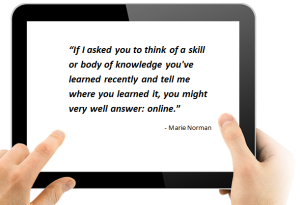 Does online learning support better teaching practices, help to create more engaging content, and provide an enhanced experience for the learner? Associations that are looking to build and develop new or existing online education programs should be very familiar with some of the points that educator and blogger Marie Norman makes about creating vs curating content, learner motivation and participation, and connecting a supportive community of peers.
Does online learning support better teaching practices, help to create more engaging content, and provide an enhanced experience for the learner? Associations that are looking to build and develop new or existing online education programs should be very familiar with some of the points that educator and blogger Marie Norman makes about creating vs curating content, learner motivation and participation, and connecting a supportive community of peers.
In a recent series of posts, Marie Norman offered the educator’s perspective on whether “Teaching Online Can Make Us Better Teachers”? The series (which was originally posted on Medium and neatly collated on eLearn Magazine this month) explores the idea that teaching online provides both new limitations and new opportunities that can push instructors to deliver more engaging content that motivates learners and enables them to better connect their learning to real world situations.
Norman notes, “there are certain attributes of online education [...] that can lead us toward smarter teaching practices." Relating Norman's article to the use of online education for continuing professional development programs by Associations, we ask - can Associations use online education for smarter professional development programs?
Online Education = More Engaging Content
When beginning to offer online education, often teachers make the first move into online learning by recording their traditional lecture delivery and providing these in video format to students. Video recordings cannot be easily changed and can become dated over time. Norman suggests that online education can open more possibilities for content delivery that creates better learning experiences, saying, “less lecture creates more space for active learning” and noting that “Online education has less investment in any particular model of teaching” and is “potentially more open to new ideas”.
 One goal many Associations share is to deliver engaging, relevant content for continuing professional development to their members and wider audiences. Many associations beginning their online teaching journey offer recorded webinars or conference sessions to members, and later progress to offering online courses delivered through a (LMS), which enable more opportunities for interaction and deeper engagement to the student. Curated content can include a mix of association-created videos and other multimedia resources from the internet or off-line sources. This enables courses to be easily updated by changing images or links to ensure the content remains relevant to learners, and incorporating different media, such as images, quizzes, text and video, facilitates multi-sensory learning, which is more engaging for learners.
One goal many Associations share is to deliver engaging, relevant content for continuing professional development to their members and wider audiences. Many associations beginning their online teaching journey offer recorded webinars or conference sessions to members, and later progress to offering online courses delivered through a (LMS), which enable more opportunities for interaction and deeper engagement to the student. Curated content can include a mix of association-created videos and other multimedia resources from the internet or off-line sources. This enables courses to be easily updated by changing images or links to ensure the content remains relevant to learners, and incorporating different media, such as images, quizzes, text and video, facilitates multi-sensory learning, which is more engaging for learners.
The other benefit of curating content for online courses in this way is that it reduces the cost of creating content and extends the life of individual courses, providing a better return on the Association’s investment. Delivering online learning through an association LMS also provides the teacher with a more meaningful understanding of the student’s mastery of the topic through the tracking and reporting functions of the LMS.
Online Education = Connecting Learners
Online education enables more active learning through more than just delivering engaging content. It can also create opportunities for learners to connect their learning to the real world. This is highly important for continuing professional development programs offered by associations, which seek to develop practical skills and knowledge for their members that can be applied in specific trades or professions.
Norman references a student who liked an online class he completed because the assignment “felt intimately connected to the real world and to the work he would soon be doing”. The fact that the assignment was both interesting and useful motivated the student to engage with the online course in order to successfully complete it. Associations can leverage the flexibility of a learning management system to create a variety of relevant courses and assessments that encourage members to engage with their programs by allowing students to incorporate their real-life work experiences into their learning.
The role of the instructor and the association could be interchangeable when Norman refers to their responsibility “to build an environment in which [learners] feel connected, welcome, and supported”. Learning management systems enable associations to create online communities connected by learning through structuring members into groups and giving access to discussion forums to facilitate learner-to-instructor or peer-to-peer conversations, support and networking. Many associations even use learning management systems to facilitate mentoring of younger members to support their learning and development. This enables members to extend their learning beyond the activities and assessments of the course, to share it with others and enhance their understanding by incorporating the perspective of others.
Norman notes, “Online education reminds us that the communities we create in our classrooms matter, whether those classrooms are physical or digital”.
If you would like to learn more about how to deliver online education for smarter professional development programs for your association members, you can explore some of our recent blog posts:






